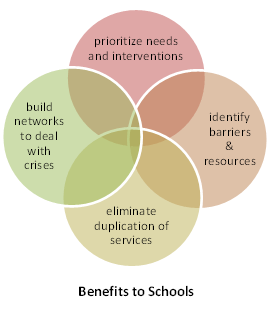The ideas and resources in this area of the website promote the enhancement of school-based child and family services. Some ideas are newly emerging but initial implementation efforts show that attention to collaborative supports, services, and interventions lead to improvement in school attendance, academic gains, reduction in high-risk behaviours and violence and increased parent involvement.
Family Strengthening
The family strengthening framework adopted by various human and health organizations takes the approach that a deliberate process of giving parents the necessary opportunities, relationships, networks and supports empowers families and enables children’s success. For vulnerable refugee families it is an especially powerful model. See Introduction to Family Strengthening.

The wraparound model
A newly emerging promising model of support is the “wraparound” or full service school. Initiatives in the US, the UK, the Netherlands and Australia have explored the idea of schools operating as full-service centres for their typically disadvantaged communities with diverse populations, where community agencies and schools work in partnership to help overcome barriers to learning. In full wrap-around models, the schools are open seven days a week and offer a range of assistance to families. The school component includes academic, behavioural and social skills instructional strategies as well as consultation and supports for teachers. The agency component includes family services including settlement, employment, and dental and medical care. The wraparound approach incorporates a plan for services and supports that requires resources from more than a single school, system or sector. Wraparound is based on the belief that families should be equal partners in creating and implementing the plan, and that the plan should be focused on the strengths and assets of the child and family as opposed to focusing on traditional deficit-based practices. As an example, see the Indiana Department of Education’s Effective Responses: Wraparound.
Alberta Education, through a partnership with the University of Alberta, the Edmonton Public School board and other jurisdictions is conducting research to inform potential wraparound implementation. For more detail, see: Literature search findings on Wraparound/Full-Service Schools.

The wraparound approach requires high levels of collaboration between schools and agencies. Although there are challenges to acquire resources to move to full “24-7” wraparound, it is still beneficial to consider the model on a smaller scale, taking advantage of the expertise and supports available through strategic partnering, consultation and informed referral processes.
From Collaborative Practices, Alberta Education
For example, at Forest Lawn High School in Calgary, Alberta, the Wellness Centre serves as a hub for school counselling services and twenty community agencies that offer a rotating schedule of services to students and their families. Service providers include, for example, Calgary Family Services, Distress Centre, Youth Employment Centre, John Howard Society, Alberta Health Services, Sexual Health Centre, Centre for Newcomers, Immigrant Youth Outreach, Big Brothers and Big Sisters Mentorship Program, YMCA, Calgary Immigrant Women’s Association, Hull Child and Family Services and McMan Youth, Family and Community Services.
For a list of community agencies which serve immigrant and refugee populations in Alberta, see the Community Agencies section.
Extended School Learning Teams
The complex factors which students with refugee backgrounds face require collaboration with resources beyond the school setting. Schools can be instrumental in assisting students and families to access and navigate the multiple service systems. Schools can serve as the hub of wrap-around support by establishing extended Student Learning Support Teams which take a case-management approach to coordinating support services, with school staff and additional district supports, and health service and community service agencies.
 In constructing the extended Student Learning Support Team schools can benefit by:
In constructing the extended Student Learning Support Team schools can benefit by:
- prioritizing the needs of the students
- choosing the intervention at the right level
- accessing appropriate resources, from within the school and/or from the community
- eliminating duplication of services
- identifying barriers and creating innovative solutions for students and families
- building networks, in advance, to deal with crises
- gaining support and broadening expertise through networking and collaboration
It is helpful if school staff support students and families by keeping track of who’s who. See, for example to Sample Newcomer Guide in the Young Learners toolkit.
Sometimes the number of people and services with which refugee families are connected can become very confusing, especially if the families have limited English. They have difficulty identifying which documents are for what purpose, and which people are who.
A useful practice was developed in the Calgary Board of Education. The staff at the Newcomer Reception Centre provide families with a binder in which plastic sheets and dividers help them keep important papers. There are inserts for business cards and photos of the personnel in the various agencies. There are fillable calendar inserts and appointment reminders. The families are invited to carry the binders to meetings and appointments. In addition to helping the families keep track of things, the various workers also know other’s involvement to avoid gaps or duplication in service.




